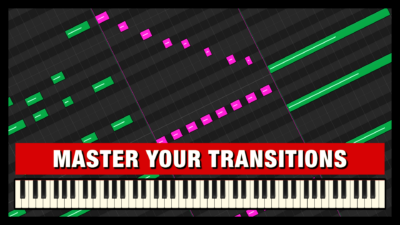 Do you want to create effective transitions in your music?
Do you want to create effective transitions in your music?
Transitions is a fundamental and extremely powerful aspect of music composition that if you make them shine, you will lift the entire production value of your music to another level.
Learn and Master Transitions in my Video Course here. Or read on to learn the fundamentals.
1. Glue Sections Together
Probably the most important aspect of transitions in music, is to glue sections together, in order to create a natural flow and keep the red thread intact throughout your music composition. For example, between the intro and verse 1, or the verse and the chorus. If you fail with this important glue, which is basically one aspect of all types and techniques of transitions in music, your sections will feel separated and new parts will feel abrupt to the listener. So, the first aspect of transitions is: Glue Sections together.
2. Build Energy
To make the listener of your music long for what will come next, and especially if you have an upcoming chorus, power section or whatever you want to call it…building energy in various ways is another cornerstone of great transitions. You can do this with specific types of sounds that naturally build up the energy, or with a range of compositional techniques. And you will learn how during this course. So, the second aspect of transitions is: Build Energy.
3. Drain Energy
This is the opposite of building energy, which is mainly used when you are going to end a section and go into a less energy intense section in your composition. For example, finishing a big chorus and going into a breakdown or bridge section. Or perhaps when finishing your final chorus and going into a calmer outro section. So, the third aspect of transitions is: Drain Energy.
4. Create Flow
Flow is one of those things that are hard to explain in music, but you can immediately hear when it is missing. It is basically part of the glue between sections, but flow is also about adjustments to dynamics, tempo, rhythm and groove, voice leading etc. The easiest way to understand flow, is to think about your music and every part inside it, as waves that you connect together into one single stream of sound. So, the fourth aspect of transitions is: Create Flow.
5. Add Spice
Sometimes the tiniest details is what is missing from your music compositions and transitions, in order to reach that highest quality and professional sound. I call this, spice. It is those small extra fills and details that are used both in transitions between sections, but more importantly, in softer transitions within the bigger sections themselves. A classic example is a drummer, who often adds tiny fills in the end of every 4 bars, or even 2 bars. You can add these spices with any instrument and any part in your music. So, the fifth aspect of transitions is: Add Spice.
6. Control Contrasts
Contrasts in music, is one of the most powerful ways to shape what impact it will have on the listener. And contrast can be created, or reduced if you want to, in so many ways. Dynamics is probably the thing most people think of. But you can do so much more than that to control contrasts in music. Layering, instrument and note density, level automation, harmonic contrast, frequency focus, and the list goes on. Since your sections by nature are different parts of your music story, you can use transitions to create, or reduce, the contrasts between them. For example, glue them seamless together for ambient music, or do a big drop using silence as the most powerful form of contrast for a truly impactful transition point into your next section. So, the sixth aspect of transitions is: Control Contrasts.
7. Mark Transition Points
This might seem obvious, but it is actually extremely important to control the power of the exact transition points between sections in your music. Not only building energy, draining energy, using composing techniques to glue them together etc. But to actual mark those points, accent them as much as you want your listener to truly feel them. The most common and easiest example of this is the classic cymbal crash, but you will learn many more ways to excel your technique in this area during this course. So, the 7th aspect of transitions is: Mark Transition Points.
Congratulations!
You have now learned the Most Powerful Aspects of Transitions in Music. Now it is time to go into the details of each, learn from practical demonstrations and examples, go through tips, tricks and techniques so you will be a master of transitions in your music compositions.
Special Discount on my Course on Creating Great Transitions
